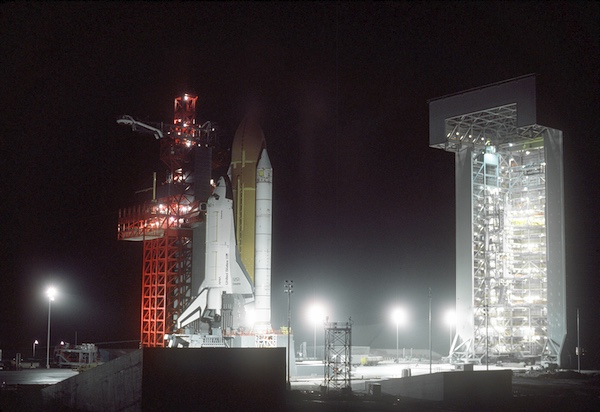The NRO and the Space Shuttleby Dwayne Day
|
| There were questions about which NRO payloads to fly on the shuttle and when, and how long to maintain a backup expendable launch vehicle capability. |
The NRO’s involvement in determining the shuttle’s design is now generally known. For instance, it has long been clear that the NRO’s largest spacecraft in the early 1970s, the bus-size HEXAGON search satellite, determined the length of the shuttle’s payload bay. The classified shuttle missions are likely to remain classified for decades to come. However, newly released information now sheds considerable light on the period between shuttle approval in 1972 and the first flight in 1981, and how NASA and the NRO cooperated to determine how and how much the national security community would use the space shuttle once it became operational. The information comes in the form of several declassified NRO documents from the 1970s on use of the space shuttle, and portions of an official history, “Sharing Space – The Secret Interaction Between the National Aeronautics and Space Administration and the National Reconnaissance Office,” written by Vance Mitchell in 2012 and recently declassified.[1]
The shuttle’s experimental nature led to skepticism that it could meet program objectives. According to Mitchell, there were questions about which NRO payloads to fly on the shuttle and when, and how long to maintain a backup expendable launch vehicle capability. There were also two major shuttle operational issues for the NRO: whether classified shuttle missions required a separate command and control facility other than Mission Control at the Johnson Space Center, and the development of a launch site at Vandenberg Air Force Base for high-inclination shuttle launches. Both of those issues have been known for decades now, but the NRO’s involvement in them has mostly been shrouded in secrecy.
Fly-before-buy
On March 20, 1975, NRO Director James Plummer signed a memorandum outlining NRO policy toward the shuttle. The directors of the individual NRO program offices (Air Force, CIA, and Navy, respectively known as Programs A, B, and C) were responsible for transitioning their missions to the shuttle. Plummer left the details on how this should be done to the program directors. As Mitchell noted, Plummer established no milestones for the transitions, although his policy made it clear that NRO would wait to see how shuttle performed before committing to it entirely, a so-called “fly-before-buy” policy. By the end of the year, the DoD established overarching plans for transitioning national security payloads to the shuttle, but the DoD plan was classified only at the secret level and did not mention the NRO, nor did it establish detailed milestones.
At that time, the plan was for the shuttle to achieve its initial operating capability in fiscal year 1980. The Department of Defense would transition its payloads starting the following year and finish during fiscal year 1985. In 1976, a Payload Accommodation Working Group began meeting. It consisted of NRO, NASA, and DoD personnel who addressed issues associated with transitioning selected payloads to the shuttle. Most of these payloads (about ten of them) remain classified to this day, although the HEXAGON search satellite that had entered service in 1971 (and which was declassified in 2011) was one of the payloads they considered.
Upper stages
The shuttle could only place payloads into low Earth orbit. Thirty-five percent of NASA and DoD satellites required additional boost beyond low Earth orbit. For years, NASA and DoD had been engaged in discussions over development of an upper stage booster to ride in the shuttle payload bay and then boost payloads into higher orbit. NASA initially chose an Inertial Upper Stage (IUS) to serve until the early 1980s. The plan was for the IUS to be replaced by a reusable Space Tug sometime between 1983 and 1986. But NASA canceled the Space Tug in 1977 due to its high cost, and instead selected the Centaur, which presented major design and safety issues for use in the shuttle bay.
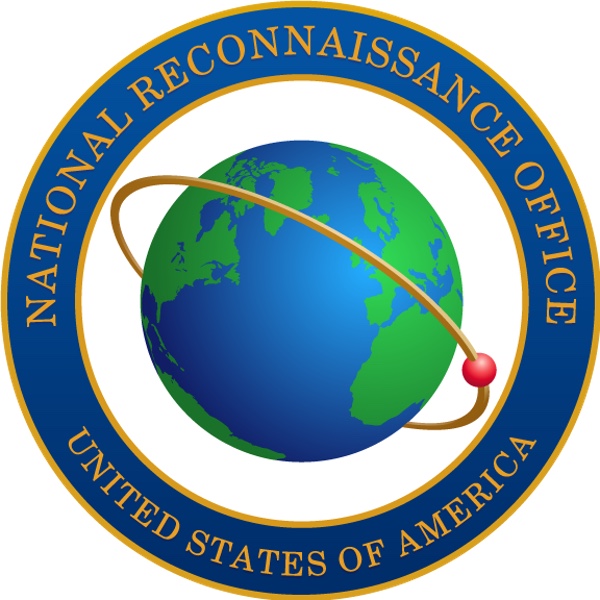 The NRO took a cautious approach initially to launching payloads on the shuttle. (credit: NRO) |
Costs, and 51 shuttle flights per year
In congressional testimony in 1976, Director of Central Intelligence George H.W. Bush stated that all NRO payloads would be transitioned to the shuttle by the early 1980s and predicted that the NRO costs would be around $250 million.
In January 1977, Charles Cook, the Deputy NRO Director, updated NRO’s guidance for use of the shuttle. He identified twelve planning objectives, including having sufficient control over operations involving NRO payloads as well as designing no payloads as shuttle-only. Cook stated: “No NRP [National Reconnaissance Program] spacecraft will be designed in a space shuttle-only configuration prior to the demonstrated capability and reliable operation of the STS,” a reiteration of the “fly-before-buy” policy.[2] Cook also indicated that the DoD should maintain an expendable launcher capability. This was also necessary in case using a shuttle on a mission during heightened world tensions was undesirable, or if a shuttle was, in his words, “neutralized.”
Cook also wanted the NRO to be able to take advantage of the shuttle’s capabilities in a stepping-stone fashion. All new NRO spacecraft or major block changes to existing systems entering design subsequent to fiscal year 1976 “will be designed in a modular configuration (provided the additional weight capability of the Space Shuttle would be advantageous to mission accomplishment) so that when the Space Shuttle has demonstrated its reliability, improvement modules can be added to the NRP spacecraft. This will allow us to take maximum advantage of the increased Space Shuttle capability.”[3]
| One reason why NASA might have decided to go easy on the NRO concerning launch costs was that the NRO apparently did not pay for launch of its satellites on Air Force rockets. |
That same month, NASA and DoD signed an agreement on what NASA would charge customers such as the NRO. The agreement was general in nature. As Hans Mark, who was NRO Director from 1977 to 1979 put it, shuttle pricing essentially involved picking numbers out of the air, and not antagonizing potential customers. NASA needed to cover its expenses, but it also needed customers willing to fly on the shuttle. Without enough of them, program justification was difficult, and so was funding.
One reason why NASA might have decided to go easy on the NRO concerning launch costs was that the NRO apparently did not pay for launch of its satellites on Air Force rockets. Although the specific details remain classified, a 1978 document indicates that because of the way the Pentagon did its accounting, the NRO was not charged launch costs for its payloads and launch costs were not included in the NRO budget. Once NRO payloads began flying on the shuttle, NASA would charge the NRO, and the NRO would have to budget accordingly.[4]
Also in January 1977, NASA and DoD agreed on managing and operating the shuttle fleet. Along with DoD, CIA, and NRO, NASA agreed on a five-orbiter shuttle fleet to meet a requirement for 560 flights from Florida and California during the first 11 years of shuttle operations, about 51 shuttle flights per year.
NASA’s plans met considerable skepticism from the Office of Management and Budget, which did not believe that the shuttle could achieve such a high launch rate. OMB recommended funding only four orbiters. President Jimmy Carter agreed.
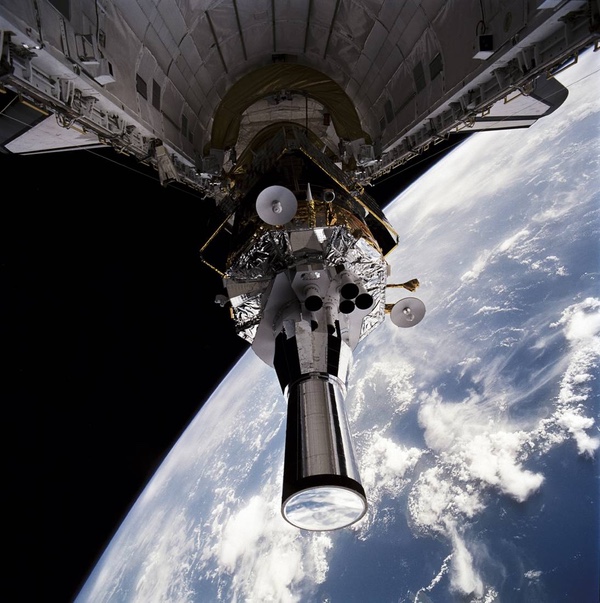 Deployment of the Defense Support Program missile warning satellite during STS-44. (credit: NASA) |
The National Space Policy and buy-before-fly
A year after that flurry of agreements, the DoD had identified various satellite systems as candidates for shuttle launch. The DoD was then operating eight satellite systems, including four communications satellite systems, one missile warning system, and two satellite systems used for navigation, positioning, and targeting. There were five DoD satellite systems in the proposal stage. The NRO was then operating eight satellite systems: the HEXAGON, GAMBIT, and KENNEN imaging satellites, and five electronic intelligence satellite systems.[5]
The eight operational DoD systems were:
Satellite Data System (SDS)
Defense Satellite Communications System (DSCS)
Air Force Satellite Communications System (AFSATCOM, mounted on SDS and FLTSAT spacecraft)
Fleet Satellite Communication (FLTSATCOM, to be replaced by LEASAT)
Defense Support Program (DSP) missile warning satellites
Global Positioning System (GPS)
Defense Meteorological Support Program (DMSP)
Transit navigation satellite
The five systems in proposal stage were:
Space Test Program (STP)
Low Altitude Satellite Study of Ionospheric Irregularities (LASSII)
Strategic Satellite System communications system
General Purpose Satellite Communications System
NATO Phase IV Communications Satellite
Also mentioned, but not included in the total, was the CLIPPER BOW ocean radar satellite. (See “Shipkillers: from satellite to shooter at sea,” The Space Review, June 28, 2021.)
The active NRO imaging systems in 1978 were:
HEXAGON
GAMBIT
KENNEN
And five signals intelligence (SIGINT) systems:
AQUACADE
CANYON
JUMPSEAT
P-989 small satellites
PARCAE ocean surveillance satellites
Although the document deletes the names of the SDS and SIGINT satellites in the listings of operational satellites, it does mention both SDS and the P-989 satellites in passing. The P-989 satellites were candidates for an early transition to the shuttle, supposedly at minimal cost.[6] (Costs may have grown once the safety requirements of shuttle launch were fully evaluated. See “Wizards redux: revisiting the P-11 signals intelligence satellites,” The Space Review, September 7, 2021.)
Although the HEXAGON satellite was then planned for transition to shuttle launch, the program was scheduled to end around the time that the Vandenberg launch facility would become active, meaning that for all practical purposes it did not make sense to transition the satellite to the shuttle. Rather ironically, although the shuttle’s payload bay was designed to accommodate the HEXAGON, it would not carry it.
There were studies underway to use the shuttle as a piloted reconnaissance platform. A series of studies known as WASP, for Wide Area Surveillance Payload, was evaluating the possibility of adapting HEXAGON camera technology to be carried in the shuttle’s payload bay. Another series of studies was addressing carrying the GAMBIT satellite camera in the shuttle bay as well. The HEXAGON-related studies and proposals continued into the 1980s, although the GAMBIT-related ones appear to have not proceeded very long.[7]
| “I was very anxious to get the military involved in the shuttle because it was in fact the most capable launch vehicle that we were building at the time,” Mark explained in a 1997 interview. |
The 1978 transition plan indicates that only one NRO program was then in the proposal stage. However, other sources indicate that there were two new programs under consideration at this time: a radar satellite and a large signals intelligence satellite. NRO made an important policy shift by early 1978, deciding to configure a still-classified CIA satellite for shuttle-only launch. Configuring it only for the shuttle and not the Titan III rocket would reduce complexity and save money. We know from other sources, such as an interview with former NRO Director Hans Mark, this was a large signals intelligence satellite whose antennas were easier to fit into the wider shuttle payload bay.
In May 1978, President Carter signed Presidential Directive NSC-37 “The National Space Policy.” This policy directed maximizing use of the shuttle. Following up on this policy, Congress ordered DoD to submit a detailed transition plan by the end of the year. This was a substantial shift away from the “fly-before-buy” policy, pushing many DoD payloads to commit to shuttle launch before the shuttle had even flown. Only payloads entering final design phases before 1980 required a backup expendable launch vehicle. All other payloads would be “shuttle optimized.” This was essentially an end to the “fly-before-buy” policy.
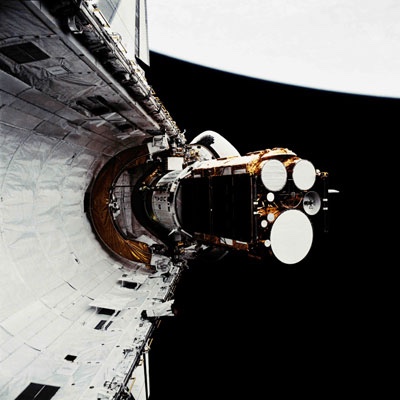 Deployment of the Defense Satellite Communications System (DSCS) satellites during STS-51-J. (credit: USAF) |
The controversial director
A key and highly controversial figure in determining what the NRO would do concerning shuttle was Dr. Hans Mark, director of the NRO. Mark had obtained his Ph.D. in physics from the Massachusetts Institute of Technology where he had also served as a researcher, and in 1969 had become director of NASA’s Ames Research Center in California, where he gained extensive knowledge of NASA as well as the space shuttle. Mark became NRO Director in August 1977. He died in December 2021.
Mark was a shuttle advocate when he took the NRO job. “I was very anxious to get the military involved in the shuttle because it was in fact the most capable launch vehicle that we were building at the time,” Mark explained in a 1997 interview. The Titan-IIID that carried the NRO’s heaviest spacecraft into orbit was not as capable as the shuttle in terms of how much it could lift, and in Mark’s view the shuttle had other advantages as well.[8] “I was very anxious to have the military take advantage of the human capability in orbit to check out satellites before you dump them” in orbit, Mark explained, “then later on to repair them on orbit. We were going to launch satellites out of the West Coast so that you could repair and fix polar orbiting birds too.”
Mark found few shuttle advocates within the military. “There were a few officers in the Air Force who really did want to use the space shuttle, but they were in the minority, and they were basically not promoted in the end,” Mark explained. Mark’s own shuttle advocacy apparently changed over time. In a book published in 1988, he sounded a different tone about the shuttle. He wrote, “On balance, I believe that the conservative attitude of the Air Force toward the space shuttle at the time was probably justified. We were to encounter delays and problems in the space shuttle program that would indeed call for a cautious approach. Perhaps the most articulate exponent of the Air Force position at that time was Mr. Jimmie D. Hill, who was then a member of the under secretary’s staff and who would later become the deputy under secretary of the Air Force for space systems.” [NRO Deputy Director] Hill was the head of the NRO’s staff and became highly respected in that position. “Hill had an encyclopedic knowledge of Air Force space systems as well as a first-class intelligence that he applied to the problems at hand. By taking positions that were generally opposed to mine, we usually arrived at workable compromises that could be implemented,” Mark wrote.[9] Mark wrote those words soon after the Challenger accident. But when he was NRO Director, before the shuttle had flown, Mark still had a much more positive view of the shuttle’s potential.
Mark said in his 1997 interview that he sought to gain funding for new NRO systems based upon President Carter’s priorities. “The political environment that was critical was the intense desire on the part of President Carter to get SALT II approved, or to finish the negotiations, and then get the Senate to ratify it,” Mark explained. “From the point of view of the NRO, of course, that was the opportunity to really expand the program, because we knew the Senate ratification process would require us to be able to get up and say yes we can monitor and verify.”
| Kulpa oversaw several efforts to use the shuttle for key NRO missions. He was apparently the key proponent in 1980 for using the shuttle as a piloted reconnaissance spacecraft. |
Despite his comments about accepting Jimmie Hill’s opposition to the shuttle, in his 1997 interview Mark argued that there was no alternative to the shuttle and he had to force the military to accept it. “It was funny to watch them. It had to be done, because of the capability inherent in the [signals intelligence satellites] and we would have had to compromise our capability if we had to fit those things into the existing launch vehicles.”
According to Mark, Secretary of Defense Harold Brown accepted his argument about the shuttle’s importance and was willing to go to see President Carter to get his support to fix the development problems the shuttle was then experiencing.
In his history, Mitchell notes that although Mark was controversial, he was essentially following the presidential directive on the shuttle, not making policy based upon his own views of the shuttle’s appeal. By January 1979, Mark established the Manned Space Flight Engineers Program to provide qualified crewmembers to handle classified payloads.
The NRO also began planning for at least one satellite retrieval and one on-orbit repair per year using the shuttle beginning around 1985. This planning may have come at White House direction. In addition, the NRO began investigating how to design satellites to withstand the different environment of the shuttle payload bay.
As the NRO was making these plans, the shuttle launch schedule slipped into 1980 and then 1981. When the first space shuttle launch took place in April 1981, the NRO was still planning to make extensive use of it throughout the 1980s. That ultimately did not happen.
The Major General
In spring 1975, when NRO Director James Plummer established the NRO’s initial policy toward transitioning payloads to the shuttle, he left the details of what payloads would transition and when to the heads of the NRO’s three mission directorates that oversaw development of many different payloads. The directorates were known as Program A (Air Force), Program B (CIA), and Program C (Navy). The positions and decisions of those mission directors are for the most part unknown, with one exception.
Major General Jack Kulpa took over Program A in Los Angeles in 1975 (this was more formally known as the Secretary of the Air Force Special Projects Office, or SAFSP.) Kulpa normally would have served in that position until 1979, but NRO Director Hans Mark respected Kulpa and believed that maintaining stability at the program offices was important, so he renewed Kulpa’s service as head of Program A/SAFSP for a second four-year-term. Mark viewed both Kulpa and his CIA (Program B) counterpart Les Dirks as “first class technical people.”[10] Mark stated that Kulpa was a shuttle supporter.
During his time running SAFSP, Kulpa oversaw several efforts to use the shuttle for key NRO missions. He was apparently the key proponent in 1980 for using the shuttle as a piloted reconnaissance spacecraft, carrying the DAMON camera system derived from the HEXAGON reconnaissance satellite, an extension of the earlier WASP studies (see “Top Secret DAMON: the classified reconnaissance payload planned for the fourth space shuttle mission,” The Space Review, July 1, 2019.) In 1982, Kulpa was also a lead advocate for using a shuttle mission to recover the last HEXAGON in orbit so that it could be returned to Earth, refurbished, and re-launched on a Titan rocket. Neither proposal was approved. It is unknown if Kulpa supported putting other SAFSP satellites onboard the shuttle, but it seems likely.[11]
Mission control
In 1976, a joint committee met to address how NASA and DoD would conduct classified shuttle missions. They focused on the time that the payloads were on the shuttle—after they were released, control would be turned over to the existing operations center for classified missions. The committee finished its report in January 1977 and recommended that DoD needed their own dedicated facilities at Johnson Space Center. This separate facility would be expensive, costing $215 million over 12 years, and would probably not be ready for the first classified launch, then set for 1982.
| In the next decade, both NASA and the NRO would find the reality of the shuttle to be significantly different than the plans they developed in the 1970s. |
A few months after the committee issued its report, NASA Deputy Administrator Alan M. Lovelace proposed an interim solution called “exception basis.” Under this proposal, DoD would take over the JSC mission simulator and Mission Control Center for specific DoD launches. This would be difficult to implement and could not happen more than four times a year, making it viable only until 1983, when the number of DoD missions increased beyond NASA’s ability to accommodate them at JSC using this policy. (The plan at that time was for one classified shuttle mission in 1982 and another in 1983, and significantly more in 1984.[12] )
By mid-1977, an Ad Hoc Committee was established to look at options. The report they delivered later in the year called for “Control Mode Operations” whereby classified payloads would be isolated from the Mission Control Center at Johnson Space Center. DoD mission controllers would be housed in a secret facility on the third floor of Mission Control. They would monitor their portion of the mission from there. The Ad Hoc Committee also recommended a separate DoD facility as the long-term solution.
There was another aspect of operations concerning which members of a shuttle crew would actually be cognizant of the payload. At least initially, the plan was apparently for only the payload specialists to know classified information about the payload, and the mission commander and pilot would be kept in the dark. This approach was changed as shuttle commanders and flight crews could be given the required security clearances.
By early 1979, the Office of Management and Budget Director asked NASA, DoD, and the intelligence community to address the issue of a separate control facility. Eventually this turned into a decision to develop a Consolidated Space Operations Center (CSOC). By early 1980, the Air Force had settled on a location near Colorado Springs and began preparing to fund a facility to be operational in 1985.
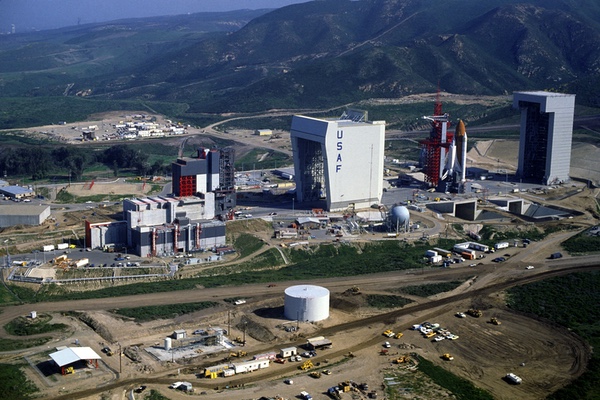 Shuttle launch facilities at Vandenberg. (credit: USAF) |
Vandenberg and only 40 shuttle flights per year
The final major issue concerning NRO use of the shuttle was the establishment of a second launch site at Vandenberg Air Force Base in California. According to Mitchell, there were no major issues between the NRO and NASA concerning this site. There were many issues involved in the construction of the Space Launch Complex-6 launch facility in the early 1980s, but they were managed by the Air Force. The National Reconnaissance Office would have been the primary user of the site. The only real issues that involved NASA concerned questions about the size of the shuttle orbiter fleet. If only three orbiters were built, Vandenberg would not be necessary.
However, during the late 1970s, the Government Accounting Office issued two reports questioning the need for a West Coast launch site and even proposed that shuttles could launch to polar orbit from Cape Canaveral. Mitchell characterized the GAO reports as not serious and based upon amateurish analysis, such as the idea that the shuttle could be launched into polar orbit from Florida.
In 1979, NASA revised its shuttle launch schedule, reducing it to 488 flights in 12 years, or about 40 flights per year for four orbiters. This would include 353 launches from the Cape and 135 from Vandenberg.
In the next decade, both NASA and the NRO would find the reality of the shuttle to be significantly different than the plans they developed in the 1970s.
Endnotes
- Vance Mitchell, Ph.D., “Sharing Space – The Secret Interaction Between the National Aeronautics and Space Administration and the National Reconnaissance Office,” NRO, 2012.
- Charles W. Cook, “NRP-STS Transition Policy,” 1977.
- Ibid.
- “Transition Plan for Defense and Intelligence Satellites to the Space Transportation System,” 1978, p. 5.
- Ibid., p. 1.
- Ibid.
- Dwayne Day, “The HEXAGON Reconnaissance Satellite and the Space Shuttle,” AIAA SciTechForum, January 3-7, 2022.
- Hans Mark interviewed by Gerald Haines, March 12, 1997, p. 15.
- Hans Mark, The Space Station: A Personal Journey, Duke University Press, 1987, p. 68.
- Hans Mark interviewed by Gerald Haines, p. 30.
- Dwayne Day, “The HEXAGON Reconnaissance Satellite and the Space Shuttle.”
- “Transition Plan for Defense and Intelligence Satellites to the Space Transportation System,” 1978, p. 7.
Note: we are using a new commenting system, which may require you to create a new account.
